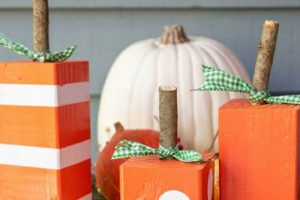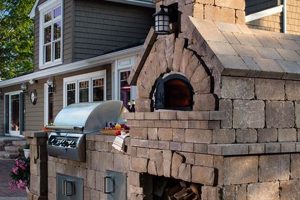The structural components crafted from timber, employed to support shelving units when assembled by the user, provide a practical solution for storage and display. These supports, often constructed in a variety of shapes and sizes, are attached to a vertical surface and extend outward to bear the weight of a shelf. An example includes triangular-shaped pieces secured to a wall stud, effectively holding a wooden plank.
The use of user-assembled timber supports offers significant advantages, including cost-effectiveness and customization. Throughout history, individuals have sought affordable and adaptable solutions for organizing their belongings. These wooden supports address this need by allowing for bespoke design choices, tailored to specific spatial requirements and aesthetic preferences. This approach also allows for the selection of sustainable materials and the potential for repurposing existing lumber.
The remainder of this discussion will explore various aspects of creating these supports, encompassing material selection, design considerations, construction techniques, and finishing options. Guidance will be provided on ensuring structural integrity and achieving desired aesthetic outcomes.
Essential Guidelines
The following recommendations are intended to enhance the durability, aesthetic appeal, and safety of shelf supports fabricated from lumber.
Tip 1: Material Selection: The choice of timber significantly impacts the structural performance and visual character of the supports. Hardwoods, such as oak or maple, offer superior strength and resistance to warping, suitable for heavier loads. Softwoods, like pine, present a more economical option for lighter applications.
Tip 2: Accurate Measurement: Precise measurement is crucial for ensuring the shelf unit is level and stable. The distance between supports should be carefully calculated based on the shelf length and the anticipated load. Use a level and measuring tape for accurate placement during installation.
Tip 3: Secure Fastening: The method of attachment to the wall or supporting structure must be appropriate for the wall type and load requirements. Employ screws of sufficient length and gauge, and consider using wall anchors for drywall or plaster walls to enhance holding power.
Tip 4: Joint Construction: The type of joint used to connect the support components influences its strength and stability. Mortise and tenon joints, while more complex to execute, offer superior strength compared to butt joints. Reinforce butt joints with screws, dowels, or metal fasteners.
Tip 5: Surface Preparation: Proper surface preparation is essential for achieving a durable and aesthetically pleasing finish. Sand the timber to a smooth surface, removing any imperfections. Apply a primer before painting or staining to improve adhesion and protect the timber.
Tip 6: Load Considerations: Calculate the maximum weight the shelf is intended to bear and design the supports accordingly. Distribute weight evenly across the shelf to prevent stress concentrations. Avoid overloading the shelf beyond its designed capacity.
Tip 7: Finishing Techniques: Select a finish that complements the overall aesthetic and protects the timber from moisture and wear. Paint provides a durable, opaque finish, while stain enhances the natural grain of the wood. Apply multiple coats of finish for optimal protection.
Adhering to these guidelines ensures the creation of reliable and visually appealing shelving solutions. Careful planning and execution are paramount to achieving a successful outcome.
The subsequent sections will delve into specific design variations and advanced construction techniques for creating unique and structurally sound shelving systems.
1. Material Selection
Material selection is paramount to the successful fabrication of shelving supports from timber. The constituent material directly dictates the load-bearing capacity, durability, and aesthetic character of the finished product. Informed material choices optimize structural performance and ensure long-term functionality.
- Wood Species and Density
The density of the selected timber correlates directly with its strength and ability to resist deformation under load. Hardwoods, such as oak and maple, possess higher densities and therefore greater structural integrity compared to softwoods like pine or fir. The choice hinges on the intended load and desired lifespan of the shelf.
- Moisture Content and Stability
The moisture content of the timber at the time of construction significantly influences its dimensional stability over time. Timber with excessive moisture content is prone to warping, twisting, and cracking as it dries. Kiln-dried lumber, with a controlled moisture content, mitigates these risks, providing a more stable and predictable material for construction.
- Grain Pattern and Aesthetics
The grain pattern of the timber contributes significantly to the visual appeal of the finished supports. Straight-grained timber offers a clean, uniform look, while figured grain patterns, such as burl or tiger stripe, add visual interest and character. The aesthetic choice should align with the overall design intent of the shelving unit.
- Sustainability and Environmental Impact
The source of the lumber impacts the environmental sustainability of the project. Opting for sustainably harvested timber from responsibly managed forests minimizes the environmental footprint. Certifications, such as those from the Forest Stewardship Council (FSC), provide assurance of responsible forestry practices.
The careful consideration of these factors pertaining to material selection is indispensable for constructing reliable, aesthetically pleasing, and environmentally responsible shelving supports. A thorough understanding of these material properties is essential for achieving optimal results in wood-based support fabrication.
2. Load Capacity
Load capacity represents a critical design parameter for user-assembled shelving supports made from timber. It dictates the maximum weight a support structure can bear without failure, deformation, or compromise of structural integrity. Accurate assessment and calculation of this capacity are paramount for ensuring safety and preventing damage to property.
- Material Properties and Shear Strength
The inherent properties of the wood, specifically its shear strength, are primary determinants of load capacity. Different wood species exhibit varying levels of shear strength; therefore, the selected timber directly impacts the weight the support can safely sustain. For instance, a hardwood, possessing a higher shear strength than a softwood, can support a heavier load given identical dimensions and design.
- Support Design and Geometry
The geometry of the support structure significantly influences its load-bearing capabilities. Triangle-shaped supports, for example, distribute weight more efficiently than simple right-angle designs. The dimensions of the support, including its thickness and depth, also play a crucial role. Increasing these dimensions generally enhances load capacity, albeit with potential aesthetic implications.
- Fastener Selection and Placement
The type, size, and placement of fasteners used to secure the support to the wall and the shelf itself directly affect the overall load capacity. Insufficient or improperly placed fasteners can create weak points, leading to premature failure under load. Screws, bolts, or lag bolts must be appropriately sized and securely anchored to both the support structure and the wall to maximize holding power.
- Load Distribution and Shelf Material
The manner in which weight is distributed across the shelf also impacts the required load capacity of the supports. Unevenly distributed loads can create localized stress concentrations, potentially exceeding the support’s safe limit. Furthermore, the material of the shelf itself contributes to the overall structural integrity of the system. Thicker, more rigid shelving materials, such as solid wood, distribute weight more evenly to the supports, reducing stress compared to thinner or more flexible materials.
Therefore, the successful construction of shelving supports involves a holistic consideration of material properties, design parameters, fastener selection, and load distribution. A comprehensive understanding of these factors is essential for ensuring that user-assembled timber supports meet the required load capacity for the intended application, promoting safety and long-term structural integrity.
3. Joint Strength
The robustness of a timber shelving support is inextricably linked to the strength of its joints. In the context of user-assembled shelving supports crafted from timber, the joints represent critical points of potential failure under load. Consequently, the method employed to join individual pieces of wood significantly determines the overall load-bearing capacity and long-term stability of the structure. Insufficient joint strength undermines the structural integrity of the entire shelving system. A poorly executed butt joint, for instance, relies primarily on the tensile strength of fasteners (screws or nails), which is often less robust compared to the shear strength offered by interlocking joint designs. Therefore, consideration of joint type becomes paramount when designing and constructing shelving that must support significant weight.
Various joint types offer differing levels of strength and complexity. Mortise and tenon joints, traditionally employed in woodworking, create a strong, interlocking connection capable of withstanding substantial shear forces. While requiring greater skill and precision to execute, they offer superior performance compared to simpler butt joints. Dowel joints, utilizing wooden pins to reinforce the connection, provide an intermediate level of strength suitable for lighter loads. Miter joints, primarily aesthetic, necessitate reinforcement with fasteners or splines to achieve adequate structural integrity. The selection of a joint type should align with the anticipated load and the skill level of the builder.
In summary, joint strength represents a foundational element in the design and construction of user-assembled timber shelving supports. The choice of joint directly impacts the shelving unit’s capacity to withstand weight and maintain structural integrity over time. While advanced joinery techniques offer superior performance, simpler methods can suffice when appropriately reinforced and applied within their load limitations. A comprehensive understanding of joint mechanics is crucial for creating safe, durable, and functional shelving solutions from timber.
4. Accurate Dimensions
Precise measurements constitute a foundational requirement for successful user-assembled timber shelving supports. Discrepancies in dimensions can compromise structural integrity, aesthetic appeal, and overall functionality of the completed shelving system. Adherence to accurate measurements during design, cutting, and assembly is therefore essential.
- Load Distribution and Stability
Dimensional inaccuracies directly impact load distribution across the supports. Uneven support heights, for instance, concentrate weight on specific points, potentially exceeding the safe load capacity of individual components. This can lead to warping, sagging, or even catastrophic failure of the shelving unit. Precise measurements ensure equal load distribution, maximizing stability and preventing premature wear or damage.
- Alignment and Level Installation
Accurate dimensions are critical for achieving proper alignment and level installation of the shelving. Supports of varying lengths will result in a tilted shelf, creating an unstable and visually unappealing outcome. Precise measurements, verified with a level during installation, guarantee a horizontal shelf surface suitable for supporting objects safely and effectively.
- Joint Integrity and Secure Fit
Dimensional precision is paramount for achieving tight-fitting and structurally sound joints. Inaccurate measurements can lead to gaps, weak connections, and a compromised ability to withstand load. For example, a tenon that is too small for its mortise will create a loose, unstable joint. Conversely, an oversized tenon may prevent proper assembly and damage the wood. Precise cuts and consistent dimensions ensure tight, secure joints that maximize the strength and stability of the overall structure.
In conclusion, the role of accurate dimensions extends beyond mere aesthetics in the context of user-assembled timber shelving. Precise measurements are directly linked to structural integrity, load-bearing capacity, and the long-term stability of the system. Neglecting dimensional accuracy introduces risks of failure and diminishes the overall quality and functionality of the shelving unit.
5. Fastening Method
The choice of fastening method represents a crucial determinant of the structural integrity and safety of user-constructed timber shelving supports. This selection directly influences the load-bearing capacity and longevity of the overall shelving system. Inadequate or inappropriate fastening techniques can result in joint failure, instability, and potential hazards, negating the benefits of selecting quality timber and employing sound design principles. For instance, employing short screws into drywall without anchors to support a heavy shelf will invariably lead to pull-out and collapse, regardless of the bracket design or wood strength.
Diverse fastening methods exist, each possessing distinct strengths and weaknesses, tailored to specific applications and materials. Wood screws, commonly used for joining timber components, offer varying degrees of holding power based on their length, gauge, and thread design. Bolts, often used in conjunction with washers and nuts, provide a more robust connection, particularly when spanning thicker materials or requiring resistance to shear forces. Anchors, designed for use with drywall, plaster, or masonry walls, distribute the load over a wider area, mitigating the risk of pull-out. The selection of an appropriate fastening method necessitates careful consideration of the anticipated load, the type of wall or supporting structure, and the properties of the timber itself. A bookcase designed to hold heavy volumes, for example, may necessitate lag bolts secured into wall studs to provide adequate support.
Therefore, the fastening method should be regarded as an integral component of the design and construction process for user-assembled timber shelving supports. A meticulous evaluation of the factors influencing fastener selection, coupled with proper installation techniques, ensures the creation of a safe, reliable, and durable shelving system. The understanding and skillful application of these principles directly correlate with the successful implementation of timber shelving projects, preventing failures and maximizing the value of the materials and effort invested.
6. Surface Finishing
Surface finishing, in the context of user-assembled timber shelving supports, extends beyond mere aesthetics; it represents a critical factor influencing the longevity, durability, and overall performance of these structural components. Untreated or inadequately finished timber is susceptible to moisture absorption, insect infestation, and ultraviolet (UV) degradation. These factors can lead to warping, cracking, and weakening of the wood, ultimately compromising the structural integrity of the shelving unit. Proper surface finishing acts as a protective barrier, mitigating these risks and extending the lifespan of the timber supports. For example, a shelving unit constructed from untreated pine and placed in a humid environment is likely to exhibit signs of decay and structural instability within a relatively short period, whereas a similar unit finished with a water-resistant sealant will remain sound for a significantly longer duration.
The selection of an appropriate surface finish depends on several factors, including the type of wood used, the intended environment, and the desired aesthetic. Oil-based finishes, such as linseed oil or tung oil, penetrate the wood fibers, providing a natural-looking, durable finish that enhances the grain. Water-based finishes offer excellent protection against moisture and UV degradation, making them suitable for outdoor or humid environments. Polyurethane finishes create a hard, scratch-resistant surface, ideal for high-traffic areas or shelves that will bear heavy loads. Stains can be applied prior to the finish coat to alter the color of the wood and enhance its grain pattern. The process of surface finishing typically involves sanding the wood to create a smooth surface, applying a primer or sealer, and then applying multiple coats of the chosen finish, allowing each coat to dry thoroughly before applying the next. The careful and deliberate application of these steps yields a professional-quality finish that protects the wood and enhances its aesthetic appeal.
In summary, surface finishing constitutes an indispensable element in the creation of user-assembled timber shelving supports. It is not merely a cosmetic enhancement but a functional imperative that protects the wood from environmental degradation, enhances its durability, and extends its lifespan. The selection of an appropriate finish, coupled with proper application techniques, is essential for ensuring the long-term performance and aesthetic appeal of timber shelving units. The challenges associated with surface finishing often involve choosing the right product for the wood type and environment, and executing the application process meticulously to achieve a uniform and durable finish. This process highlights the importance of research, preparation, and careful execution in realizing the full potential of user-assembled timber shelving.
7. Design Aesthetics
Design aesthetics plays a crucial role in the integration of user-assembled timber shelving supports within a designated space. These supports are not merely functional elements but contribute significantly to the overall visual harmony and stylistic coherence of the interior environment. Careful consideration of design aesthetics elevates shelving from a purely utilitarian feature to an intentional design statement.
- Form and Proportion
The shape and relative dimensions of timber supports directly influence the visual impact of the shelving unit. Sleek, minimalist designs complement contemporary spaces, while ornate or rustic forms suit traditional settings. The proportions of the supports should be balanced relative to the size and weight of the shelves, creating a visually harmonious and structurally sound composition. For instance, overly bulky supports can overwhelm a delicate shelf, while slender supports may appear inadequate for a substantial load.
- Material and Finish
The choice of timber species and the applied finish contribute significantly to the aesthetic character of the supports. The natural grain patterns and color variations of different woods offer a wide range of visual possibilities. Finishes, such as stains, paints, or clear coats, can further enhance or alter the appearance of the wood, aligning it with the desired aesthetic. A dark stain on oak supports, for example, might complement a traditional library, while a white-painted finish on pine supports would suit a modern, minimalist interior.
- Hardware and Details
The selection of hardware, such as screws, bolts, or decorative brackets, contributes to the overall aesthetic impression. Exposed hardware can be either functional or decorative, depending on the chosen style. Minimalist designs often feature concealed fasteners to maintain a clean, uncluttered look, while rustic designs may showcase exposed hardware as a deliberate design element. Intricate metal brackets, for example, can add a touch of vintage charm to a shelving unit.
- Contextual Integration
The design of timber supports should harmonize with the surrounding architectural elements and furnishings. The style, color, and materials of the supports should complement the existing decor, creating a cohesive and visually appealing space. A shelving unit designed for a modern living room, for instance, should reflect the clean lines and minimalist aesthetic of the space, while a shelving unit designed for a rustic cabin should incorporate natural materials and textures that evoke a sense of warmth and authenticity.
The integration of design aesthetics into the construction of user-assembled timber shelving supports transforms these functional elements into intentional design features. By carefully considering form, material, hardware, and contextual integration, individuals can create shelving units that are not only structurally sound but also visually appealing and harmonious with their surroundings.
Frequently Asked Questions
The following section addresses common inquiries regarding the design, construction, and application of user-assembled timber shelving supports. These answers aim to provide clarity and guidance for individuals undertaking such projects.
Question 1: What constitutes the most appropriate wood species for constructing shelf supports intended to bear heavy loads?
Hardwoods, such as oak, maple, or cherry, exhibit superior strength and resistance to deformation compared to softwoods. These species are recommended for shelving systems designed to support significant weight. Softwoods, like pine or fir, may be suitable for lighter applications, but their load-bearing capacity is inherently limited.
Question 2: How can the structural integrity of a timber shelf support be maximized?
Structural integrity is enhanced through careful material selection, precise joinery, and appropriate fastening techniques. Utilizing high-quality hardwoods, employing robust joints such as mortise and tenon, and securing the support to the wall with appropriately sized fasteners are essential practices.
Question 3: What factors should be considered when determining the spacing between shelf supports?
The spacing between supports depends on the shelf material, thickness, and the anticipated load. Thicker, more rigid shelf materials allow for wider spacing. Increased load requirements necessitate closer support intervals to prevent sagging or failure. Consultation with load-bearing charts or engineering guidelines is recommended.
Question 4: Is surface finishing a necessary step in the construction of timber shelf supports?
Surface finishing is highly recommended to protect the timber from moisture, UV damage, and insect infestation. Applying a sealant, paint, or varnish extends the lifespan of the support and maintains its structural integrity over time. The specific type of finish should be selected based on the environmental conditions and aesthetic preferences.
Question 5: What are the risks associated with overloading a timber shelving system?
Overloading a timber shelving system poses a significant risk of structural failure, potentially resulting in damage to property and injury to individuals. Excessive weight can cause supports to buckle, joints to separate, or shelves to collapse. Adherence to load-bearing guidelines is imperative.
Question 6: How can dimensional inaccuracies impact the stability of a timber shelf support?
Dimensional inaccuracies introduce imbalances in load distribution and can compromise the stability of the shelving system. Uneven support heights, misaligned joints, or improperly sized components can lead to instability and increase the risk of failure. Precision in measurement and execution is essential for achieving a stable and reliable shelving unit.
Careful attention to material selection, construction techniques, and load considerations contributes to the creation of safe, durable, and aesthetically pleasing shelving solutions. Prioritize structural integrity and adhere to established guidelines to ensure the long-term performance of timber shelf supports.
The following section will provide a conclusion for the entire article.
Conclusion
The preceding exploration of user-assembled timber shelving supports has elucidated critical design, construction, and application considerations. These supports, frequently termed “diy shelf brackets wood,” demand careful attention to material selection, load capacity assessment, joint strength, dimensional accuracy, fastening methods, and surface finishing techniques. Neglecting these factors compromises structural integrity and diminishes the long-term viability of the shelving system.
Therefore, the successful implementation of timber shelving projects hinges on a comprehensive understanding of woodworking principles and a commitment to meticulous execution. Prudence dictates thorough planning and adherence to established guidelines, thereby ensuring safe, durable, and aesthetically pleasing shelving solutions. Future endeavors should prioritize sustainable material sourcing and innovative design approaches to optimize the functionality and environmental impact of these fundamental structural elements.







